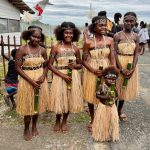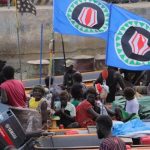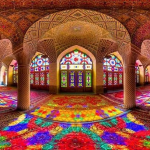This small city — which is also the capital of the province by the same name — is located about 150km south of Phnom Penh. Its charming downtown, unlike most other Cambodian cities, has preserved much of its original colonial architecture, giving Kampot a homely and distinctively French flair.
However, the area—particularly on the international scene—is best known as the home of Kampot Pepper. Such is the product’s gastronomic reputation that it became the first Cambodian food item to receive protected status from the European Union. This places Kampot Pepper alongside prestigious products like Champagne, Cheddar Cheese, and Parma Ham, all of which must come from specific regions to be sold under their names.
Partly because of this, the city is gaining a reputation as the unofficial Khmer culinary capital. It may even be on its way to becoming Cambodia’s answer to Tokyo’s ubiquitous sushi bars or the artisanal farmers’ markets of rural England. Don’t believe me? The city has already invested in a giant durian statue and a monument honoring its salt workers at key roundabouts.
Even for non-foodies, visiting a pepper plantation is a unique and fascinating experience. The evolution of the pepper industry — peaking during the French colonial era, experiencing haphazard cultivation in the early days of independence, suffering utter devastation under the Khmer Rouge, and undergoing a cautious yet steady renaissance in the 21st century — mirrors Cambodia’s own history.
By exploring the history and socio-economic impact of the industry, especially for what its revitalization reveals about modern Cambodia, we hope your visit to a Kampot Pepper farm is especially meaningful.
A quick history of Kampot Pepper:
Chinese explorers documented pepper cultivation in the Kampot region as far back as the 13th century. However, it wasn’t until (surprise surprise) the French arrived 600 years later that the name “Kampot” became associated with the finest pepper in the world.
Several factors culminated in the pepper industry growing roots in Kampot, which occurred as the colony of French Indochina was established in the 1870s.
Of course, a French penchant for fine culinary produce, combined with Kampot’s ideal growing conditions – rich soils and the moderating influence of the Gulf of Thailand – played a major role. At the same time, many sultanates in Indonesia – major pepper producers under Dutch control – destroyed their pepper plantations in rebellion against their colonial rulers. Seizing this opportunity, the French were only too happy to fill the gap in the market by using Kampot to replace Indonesian suppliers.
By the turn of the century, over 8,000 tons of Kampot Pepper were being produced, with most of it being shipped off to the finest restaurants back in la République. After Cambodia gained independence in the 1950s, production dropped to around 3,000 tons due to political instability and a national focus on producing staple crops such as rice. Despite this, Kampot Pepper remained highly sought after and continued to be one of Cambodia’s most important cash crops. Simply put, no respectable chef in Paris could be without it.
Tragically (yet unsurprisingly) the catastrophe of the Khmer Rouge’s rule over Cambodia was just as disastrous for the Kampot Pepper industry. The regime, which you can read more about in our series here, wanted to turn Cambodia into an autarkic state, forcing everyone into the countryside to grow staple crops, mainly rice. Over four years, their governance caused the deaths of an estimated 2 million people in what is known as the Cambodian Genocide.
The Khmer Rouge’s fervent disdain for intellectualism, capitalism and all things foreign meant that the Kampot Pepper industry had to go. As a luxurious cash crop – and one associated with the worst excesses of French colonial rule – it symbolized everything that the Communists despised in Cambodia. The pepper plants were destroyed and replaced with rice, which was an unmitigated disaster given Kampot’s unsuitable growing conditions for rice and citizen’s lack of expertise in its cultivation.
As Cambodia struggled through the end of the 20th century, first as a Vietnamese satellite state and then under UN protection, most people’s focus was on simply surviving rather than regenerating the Kampot Pepper industry. However, as the country has gotten back on its feet in the last 25 years, a combination of entrepreneurial Cambodians and support from various outside organizations has helped revive the industry.
Today, production remains artisanal, with an average yield of around 100 tons per year in the past decade. Yet, Kampot Pepper has clearly regained its status as a sought-after ingredient and a source of national pride, especially in the Kampot region. This resurgence is perhaps best represented by La Plantation, one of the country’s most remarkable pepper farms.
Touring La Plantation: Kampot’s boutique pepper farm:
We’ve established that Kampot is a great destination in its own right, with its laid-back vibe, an abundance of activities, and a nice mix of international and Cambodian influences.
Several different pepper farms in the Kampot area welcome visitors, but La Plantation seems to have the best facilities for tourists. It also has cute boutiques in downtown Kampot and Phnom Penh, in case you don’t have time for the full trip.
Getting to La Plantation is relatively simple. It’s around 20km east of Kampot, albeit on an atrocious road that was undergoing construction during our visit. You can either rent a motorbike to drive yourself (ubiquitous in town and available for $5 a day) or hire a tuk-tuk driver for a day trip that can also include a visit to the quaint beach town of Kep. We paid $30 for the tuk-tuk tour, which seems to be the going rate and comes highly recommended!
On the way, we stopped at the Secret Lake. It emerges out of nowhere and is surrounded by rolling mountains on all sides, almost as if it is sitting in a bowl. Tragically, the “secret” here is not that the lake is a hidden gem, but instead that it was created by a dam built using slave labour under the Khmer Rouge regime.
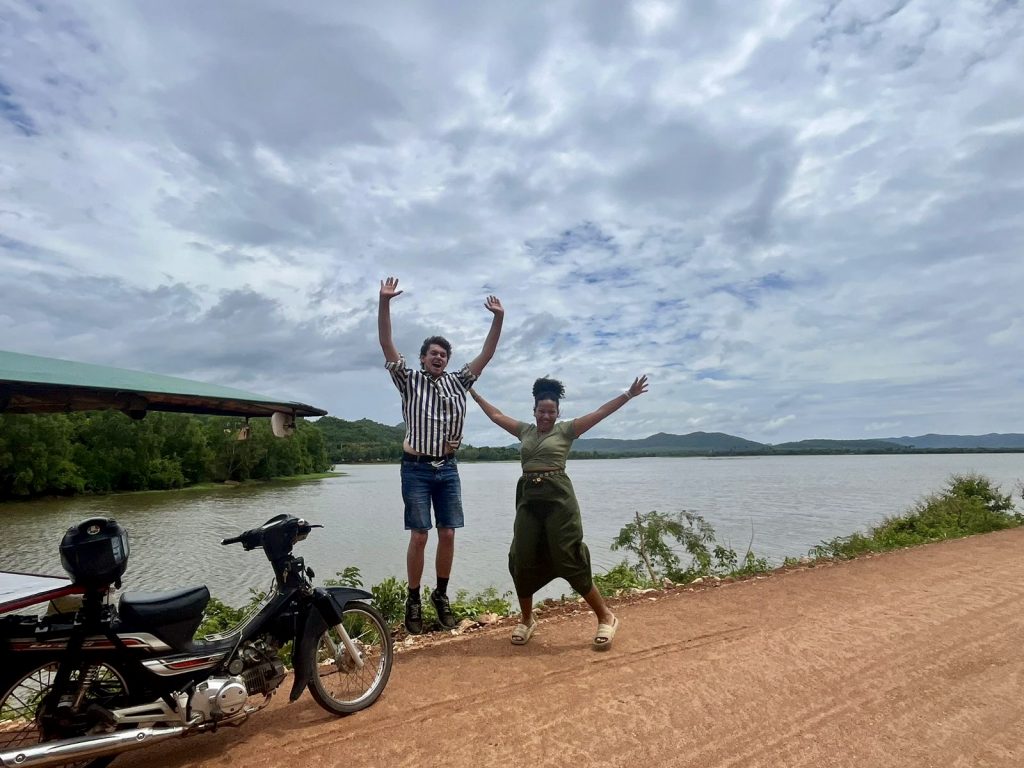
Another 15 minutes later, your arrival at La Plantation is marked by some rather grand signage and a Fifteen minutes later, you’ll arrive at La Plantation, marked by grand signage and a noticeable improvement in the road quality. The drive up to the reception is about 1km, reminiscent of a European boulevard, except each side is lined with pepper vines!
You’ll walk through a fragrant garden featuring some of Cambodia’s finest indigenous plants before reaching the central pavilion. Attention to detail is everywhere, and many buildings are in the traditional Khmer style known as Sala Chan. These structures are built on stilts to protect its inhabitants against critters and humidity, and act as the village’s Buddhist Pagoda. Because of this, smoking and wearing shoes are not allowed in the visitor’s center, but the beautiful views and smörgåsbord of pepper-related products more than make up for it!
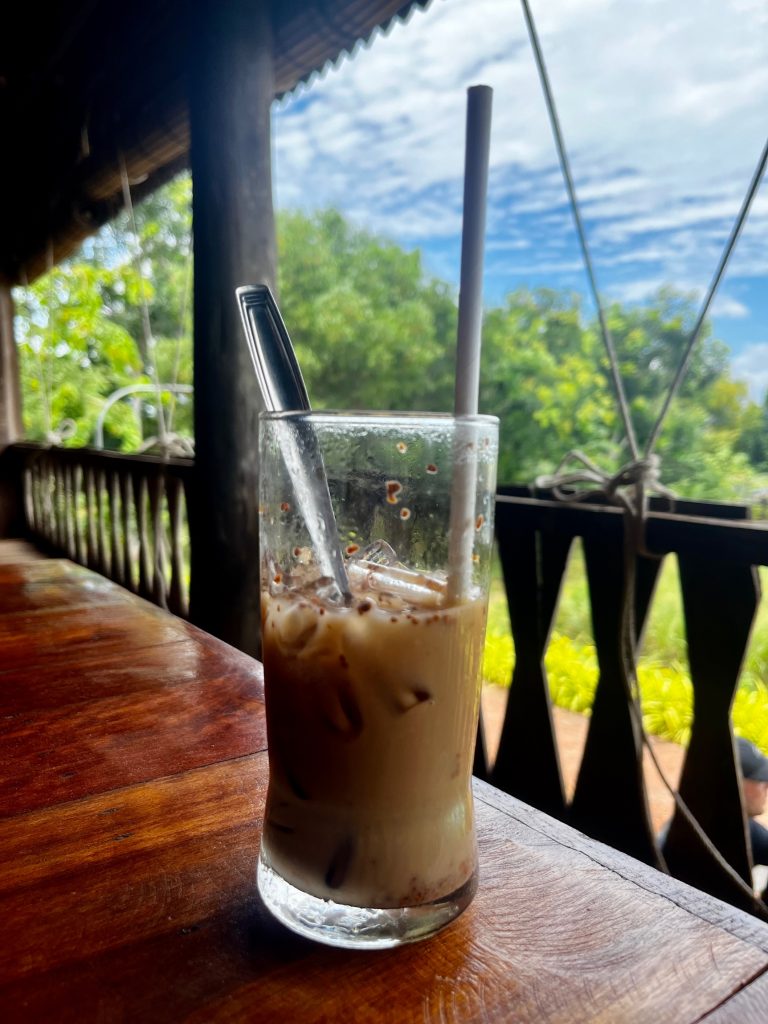
Tours are offered in English and French roughly every hour, and best of all, they’re free! However, we recommend being a good guest and tipping generously. Our guide was excellent and achieved the perfect balance of being informative and engaging without boring everyone to death.
We learnt about the history of La Plantation, established in 2013 by a Franco-Belgian couple. Foreigners cannot own land in Cambodia, but their contributions to the community were so significant that the King granted them citizenship to get around this rule. They’ve established schools in the local area and pay all their workers a living wage. The organization’s local reputation seems to be very positive.
As well as seeing the plants up close and getting some artsy (or perhaps pretentious) photos for the ‘gram, the highlight was a comprehensive tasting session of the farm’s pepper varieties – more than I knew ever existed! In addition to the signature black pepper, there were green, red, smoked, salted, and dried versions of each. We tasted at least a dozen varieties, most of which were delicious, although some tested my British spice tolerance!
If you have demanding relatives who expect gifts then you’ll have a field day in the onsite boutique. Besides peppercorns, they offer spice mixes, dried fruits, and Khmer spice sauces. The prices aren’t cheap (and the products are definitely for the “foodies” in your life) but you know you’re getting the real thing while supporting a great cause.
They also offer Khmer cooking classes ($27, reserve in advance) and luxury villas ($150-200 a night), but our limited budgets meant that we gave them a miss. Their on-site restaurant also comes highly recommended, with all dishes featuring their Kampot Pepper. Prices are also not much higher than the more average options back in town, and there’s a good selection of veggie stuff.
To summarize:
Being based in Cambodia, we naturally have a soft spot for the country, and Kampot’s attractions speak for themselves. The revitalization of the pepper industry not only symbolizes a resurgent interest in Khmer cuisine and agriculture but also reflects Cambodia’s wider journey toward recovery and growth.
Visiting Kampot and its pepper farms – especially La Plantation – provides a unique opportunity to explore a rich history, connect with local culture, and witness the pride that the people of Kampot take in their world-renowned pepper.
You don’t need to be a food enthusiast to enjoy a visit to the pepper farms; all you need is curiosity and an appreciation for Cambodian history and culture.



